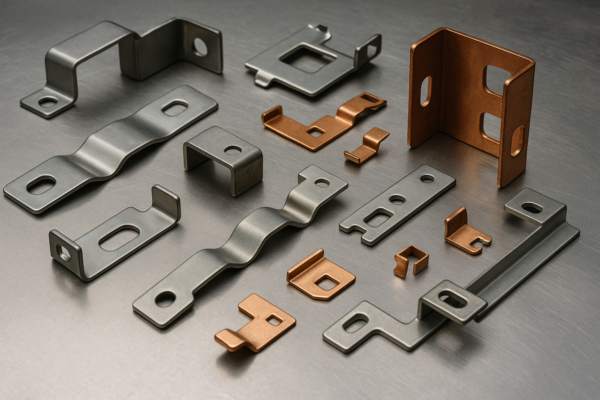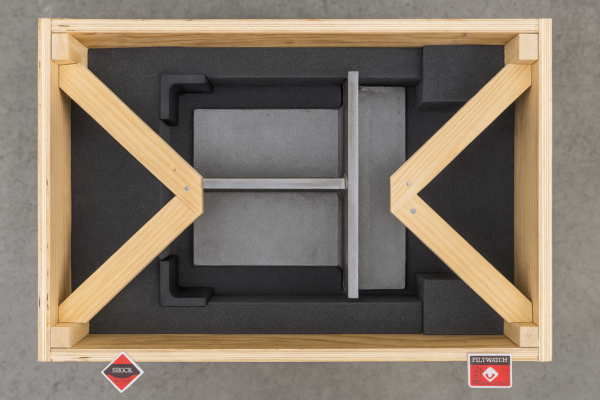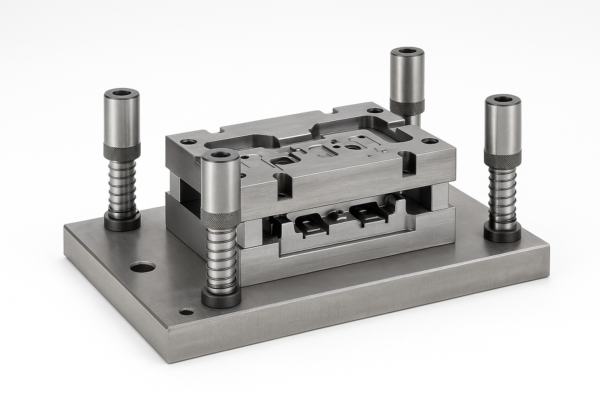What Are the Most Cost-Effective Materials for Industrial Stamping Parts?
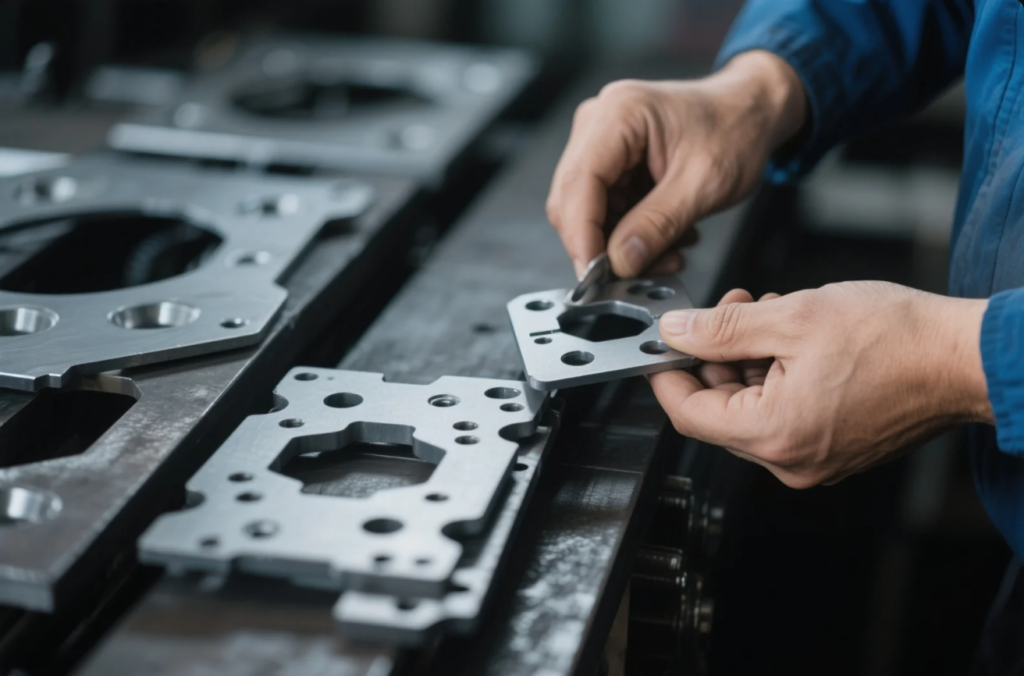
Selecting materials for stamping projects often feels like an impossible balancing act. I\’ve struggled with budget constraints while trying to maintain quality, leading to difficult compromises and occasional failures.
The most cost-effective materials for industrial stamping parts balance initial cost with performance requirements. Carbon steel offers excellent value for general applications, while aluminum provides weight savings, stainless steel delivers corrosion resistance, and copper alloys excel in electrical conductivity.
Making informed material choices can significantly impact your project\’s success and profitability. Let\’s explore the options that provide the best overall value across different applications.
How does carbon steel compare to other materials for stamping applications?
I once specified an expensive alloy for a simple bracket, only to learn later that carbon steel would have performed equally well at one-third the cost.
Carbon steel offers the best balance of cost, strength, and formability for most industrial stamping applications. Its wide availability and established processing methods make it 30-40% more cost-effective than specialty alloys while providing excellent mechanical properties.
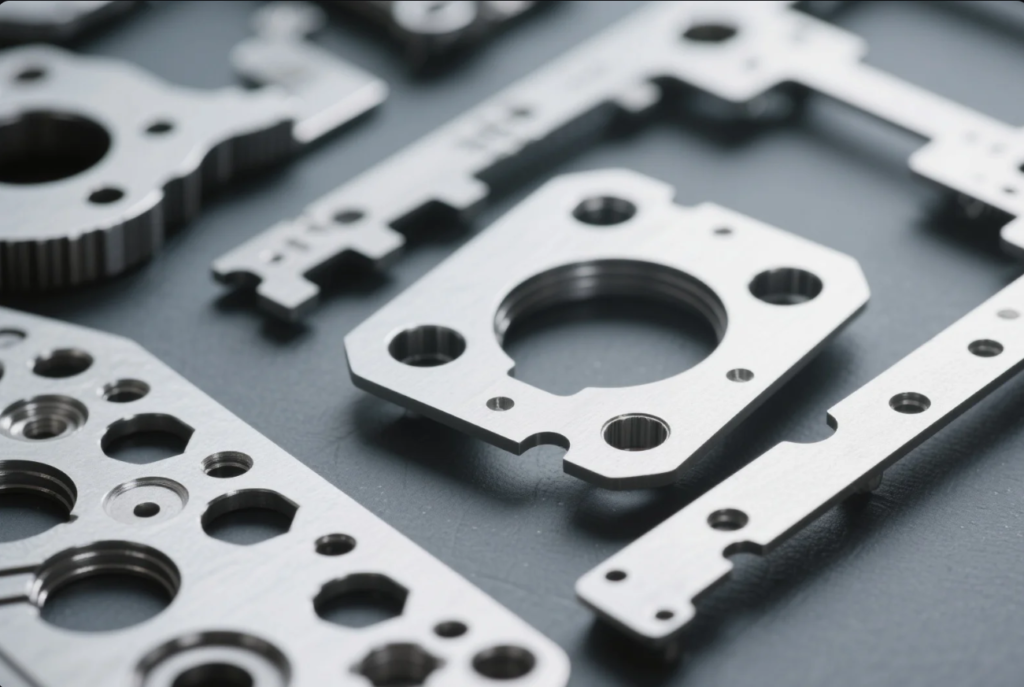
Carbon steel remains the workhorse material in the stamping industry for good reasons. Its combination of reasonable cost, good formability, and reliable performance makes it the default choice for many applications. My experience working with various materials has consistently shown that carbon steel provides exceptional value when properly specified.
Understanding Carbon Steel Grades for Stamping Applications
Not all carbon steels are created equal. The specific grade significantly impacts both formability and final part performance.
| — | ||||||||||
|---|---|---|---|---|---|---|---|---|---|---|
| Low Carbon (1008, 1010) | 0.08-0.10% | Deep drawn parts, complex forms | $ | Excellent formability, good weldability | ||||||
| Medium Carbon (1030, 1045) | 0.30-0.45% | Structural components, brackets | $$ | Better strength, moderate formability | ||||||
| High Carbon (1060, 1095) | 0.60-0.95% | Springs, cutting edges | $$$ | High strength, limited formability | ||||||
| HSLA Steels | 0.05-0.25% + alloys | Structural parts, automotive | $$$ | High strength-to-weight ratio |
During my consultation with Prime\’s engineering team, they recommended 1010 steel for my forming-intensive application instead of the 1045 I had initially specified. This change improved formability while meeting all strength requirements, reducing scrap rates by 15% and lowering overall costs.
Cost-Benefit Analysis of Carbon Steel vs. Alternatives
When evaluating materials for stamping applications, it\’s important to consider the total cost impact rather than just material price.
The true cost advantage of carbon steel becomes apparent when considering:
- Material acquisition costs (typically 30-50% lower than stainless steel)
- Tooling costs (tools for carbon steel often last longer due to lower forming forces)
- Processing costs (faster production speeds, fewer annealing steps)
- Finishing requirements (many applications need only minimal finishing)
- Scrap value (easily recycled, maintaining some material value)
For a recent high-volume bracket project, I conducted a comprehensive cost analysis comparing carbon steel to stainless steel and aluminum alternatives. The carbon steel solution reduced total project cost by 27% compared to stainless steel and 12% compared to aluminum, while meeting all performance requirements.
When is aluminum the most cost-effective choice for stamping parts?
I initially rejected aluminum for a mounting bracket due to its higher material cost, but later discovered its lighter weight eliminated the need for counterbalancing components, resulting in overall system savings.
Aluminum is most cost-effective for stamping parts when weight reduction is valuable, such as in transportation applications where lighter components improve fuel efficiency. Despite higher material costs, aluminum\’s excellent strength-to-weight ratio and corrosion resistance often reduce total system costs.

Aluminum\’s higher material cost often creates the perception that it\’s always a premium option. However, my experience has shown that taking a systems approach to material selection often reveals aluminum to be the most economical choice when all factors are considered.
Comparing Aluminum Alloys for Stamping Applications
The specific aluminum alloy selected dramatically impacts both formability and final part performance.
| — | ||||||||||
|---|---|---|---|---|---|---|---|---|---|---|
| 1100 | Excellent | Low | Simple formed parts, decorative items | Soft, easily formed, limited strength | ||||||
| 3003 | Very Good | Moderate | General purpose, moderate strength needs | Good balance of formability and strength | ||||||
| 5052 | Good | Good | Marine applications, appliances | Excellent corrosion resistance | ||||||
| 6061 | Moderate | High | Structural components, brackets | Heat treatable for increased strength |
When consulting with Prime about an electronics housing project, their material specialists recommended 5052 aluminum instead of the more expensive 6061 I had specified. The 5052 alloy provided better formability while meeting all strength and corrosion resistance requirements, reducing production costs by approximately 15%.
The Hidden Cost Benefits of Aluminum
Looking beyond the raw material price reveals several areas where aluminum can provide cost advantages:
- Reduced shipping costs due to lighter weight (typically 65% lighter than steel)
- Elimination of certain finishing processes due to natural corrosion resistance
- Lower energy costs in manufacturing due to easier forming
- Extended product life in corrosive environments
- Higher scrap value for manufacturing waste
For a recent transportation industry project, I initially calculated a 22% cost premium for aluminum components. However, when factoring in weight-related fuel savings over the product lifecycle and reduced maintenance costs, the aluminum solution actually provided a 15% lower total cost of ownership compared to the carbon steel alternative.
How cost-effective is stainless steel for industrial stamping applications?
I once specified standard carbon steel for a food processing component to save costs, only to face expensive replacements and production downtime when corrosion issues emerged within months.
Stainless steel is cost-effective for stamping parts exposed to corrosive environments or requiring sanitary surfaces. Though material costs are 3-5 times higher than carbon steel, the elimination of coating processes and extended service life often provide better long-term value.
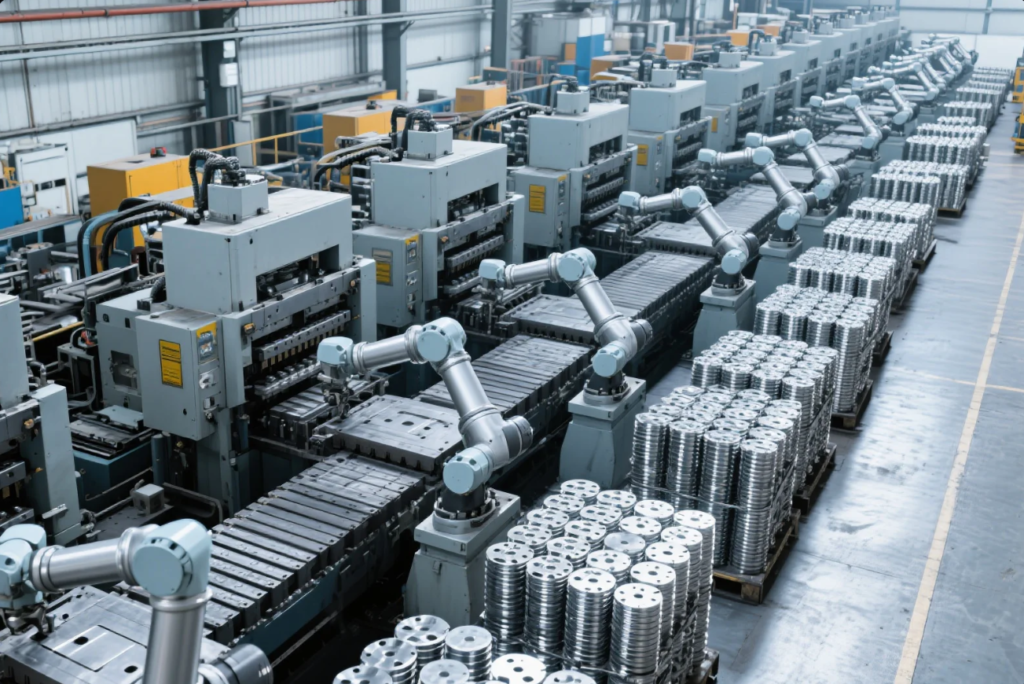
The initial price premium for stainless steel often creates sticker shock, but my experience managing components in demanding environments has demonstrated that this premium is frequently justified by superior performance and reduced maintenance costs over the product lifecycle.
Selecting the Right Stainless Steel Grade for Cost-Effective Performance
Different stainless steel grades offer varying combinations of formability, strength, and corrosion resistance at different price points.
| — | ||||||||||
|---|---|---|---|---|---|---|---|---|---|---|
| 304 (18-8) | Good | Excellent | $$$ | Food equipment, chemical processing | ||||||
| 316 | Good | Superior | $$$$ | Marine environments, medical equipment | ||||||
| 430 | Very Good | Good | $$ | Indoor applications, decorative parts | ||||||
| 410 | Moderate | Moderate | $$ | Parts requiring hardening, mild environments |
During a project for outdoor electrical enclosures, Prime\’s engineers suggested using 304 stainless steel rather than coated carbon steel. While the material cost was higher, the elimination of coating processes and inspection steps actually resulted in comparable unit costs with significantly better field performance.
Life-Cycle Cost Analysis for Stainless Steel Components
The true value of stainless steel becomes apparent when considering the entire life cycle of the component:
- Elimination of secondary finishing operations (plating, painting)
- Reduced inspection and quality control costs
- Extended service life in challenging environments
- Minimal maintenance requirements
- Higher end-of-life recycling value
For a food processing equipment project, I conducted a 5-year cost analysis comparing 304 stainless steel components to coated carbon steel alternatives. Despite a 40% higher initial cost, the stainless steel solution reduced total ownership costs by 27% due to eliminated recoating requirements and avoided production downtime for component replacement.
I initially balked at the cost of copper alloys for an electrical connector project, but after calculating the performance benefits and reduced assembly costs, the premium material proved to be the most economical solution.
Copper alloys are cost-effective for stamping parts requiring excellent electrical conductivity, thermal transfer, or antimicrobial properties. Despite material costs 4-6 times higher than steel, their unique properties enable design simplification and performance benefits that often justify the investment.
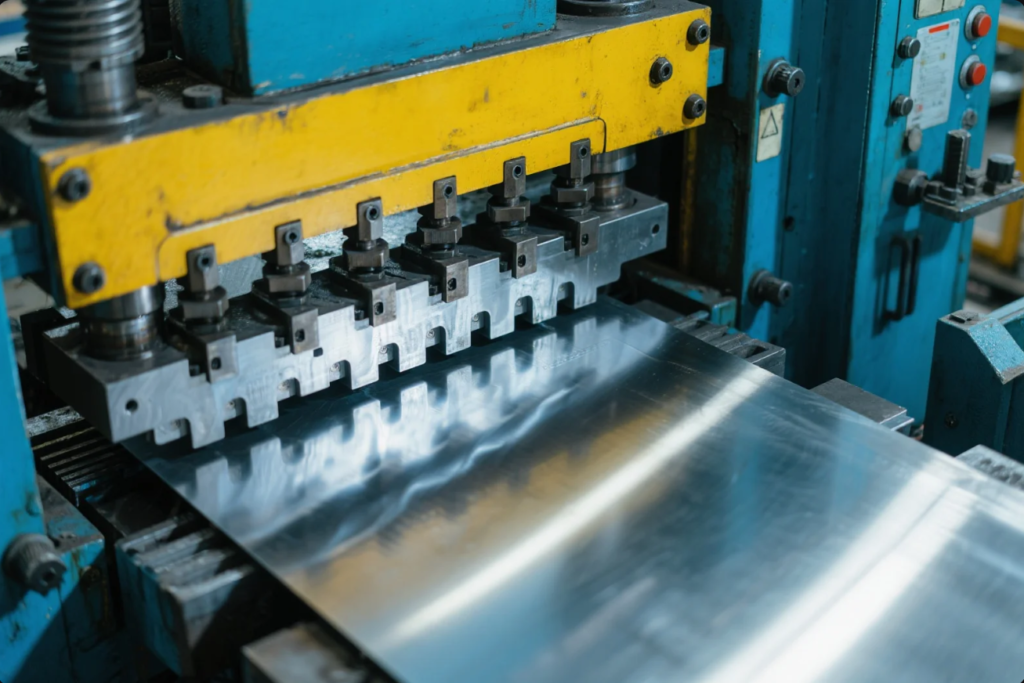
Copper alloys represent a significant price premium compared to steel or aluminum, but their unique properties enable solutions that would be impossible or impractical with other materials. My experience with electrical components has shown that copper\’s benefits often outweigh its costs in specialized applications.
Comparing Copper Alloys for Specific Applications
The copper alloy family offers a range of options with different property combinations and cost implications.
| — | ||||||||||
|---|---|---|---|---|---|---|---|---|---|---|
| C11000 (ETP Copper) | Highest conductivity | $$$$ | Electrical connectors, busbars | Maximum electrical efficiency | ||||||
| C26000 (Cartridge Brass) | Excellent formability | $$$ | Deep drawn parts, decorative items | Good balance of properties and cost | ||||||
| C51000 (Phosphor Bronze) | Spring properties | $$$$ | Electrical contacts, springs | Fatigue resistance, reliability | ||||||
| C70600 (Copper-Nickel) | Corrosion resistance | $$$$$ | Marine components, heat exchangers | Extended life in harsh environments |
When working with Prime on an electrical connector project, their material specialists recommended C26000 brass instead of the more expensive C11000 copper I had initially specified. The brass provided sufficient conductivity while offering better formability and spring properties, reducing both material and production costs.
Application-Specific Value of Copper Alloys
The cost premium for copper alloys is justified in applications where their unique properties provide tangible benefits:
- Electrical applications where conductivity reduces energy losses
- Thermal management where heat transfer efficiency is critical
- Applications requiring antimicrobial surfaces
- Components needing both conductivity and spring properties
- Parts exposed to specific corrosive environments
For a recent medical device project, I initially hesitated at the 65% cost premium for antimicrobial copper alloy components. However, the material\’s ability to reduce microbial contamination eliminated the need for separate antimicrobial treatments and enhanced the product\’s market value, ultimately improving overall profitability despite the higher material cost.
How do specialty alloys compare in cost-effectiveness for demanding applications?
I once specified a standard alloy for a high-temperature application to reduce costs, resulting in premature failure and an emergency redesign that cost far more than using the right material initially.
Specialty alloys like Inconel, titanium, and high-performance steels are cost-effective for stamping parts facing extreme conditions where standard materials would fail. Despite costs 8-15 times higher than carbon steel, their unique performance prevents expensive failures in critical applications.

Specialty alloys represent the premium end of the material spectrum, with costs that can seem prohibitive at first glance. However, my experience with demanding applications has shown that these materials often provide the only viable solution for certain operating conditions, making their cost justified by necessity rather than choice.
Comparing Specialty Alloys for Extreme Conditions
Various specialty alloys address specific extreme operating conditions with different cost implications.
| — | ||||||||||
|---|---|---|---|---|---|---|---|---|---|---|
| Inconel (625, 718) | High-temperature strength | 10-15x | Aerospace, chemical processing | Functions where others fail | ||||||
| Titanium Alloys | Strength-to-weight, biocompatibility | 15-20x | Medical, aerospace, chemical | Enables unique capabilities | ||||||
| Hastelloy | Extreme corrosion resistance | 12-18x | Chemical processing, marine | Prevents catastrophic failures | ||||||
| Monel | Seawater resistance | 8-12x | Marine, oil & gas | Extended life in harsh environments |
During a consultation with Prime for a chemical processing component, their engineers confirmed that my specification of Inconel 625 was indeed necessary despite its high cost. The operating environment would rapidly degrade any lower-cost alternative, resulting in dangerous failures and production shutdowns.
Justifying Specialty Alloy Costs Through Risk Analysis
The extreme cost of specialty alloys requires careful justification through risk assessment and failure cost analysis:
- Quantifying the cost of potential failure (safety, downtime, replacement)
- Assessing the probability of failure with alternative materials
- Calculating the expected lifetime of different material options
- Evaluating maintenance and inspection requirements
- Considering regulatory and liability implications
For a critical aerospace component, I conducted a comprehensive risk analysis comparing a specialty alloy solution to a more standard material. Despite a 280% higher initial cost, the specialty alloy provided a 65% lower total cost of ownership when accounting for reduced inspection requirements, extended service intervals, and eliminated risk of catastrophic failure.
How does material thickness optimization impact cost-effectiveness in stamping?
I once specified standard sheet thickness based on previous designs, missing an opportunity to reduce material costs by 22% through engineering analysis and thickness optimization.
Optimizing material thickness significantly impacts stamping part cost-effectiveness. Reducing thickness where possible while maintaining performance can save 15-30% in material costs, while strategic thickening in high-stress areas can prevent failures and costly redesigns.
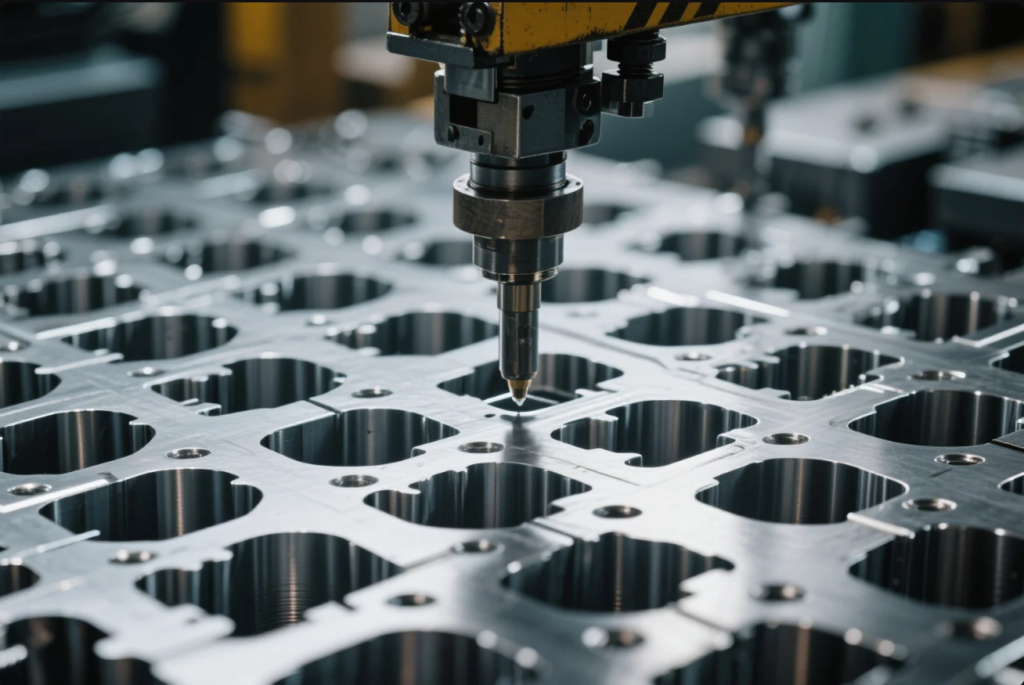
Material thickness is often determined by historical precedent rather than engineering analysis, creating opportunities for significant cost savings through optimization. My experience with high-volume components has shown that even small thickness reductions can dramatically impact project economics when multiplied across thousands or millions of parts.
Thickness Optimization Strategies for Different Materials
The approach to thickness optimization varies based on material properties and application requirements.
| — | ||||||||||
|---|---|---|---|---|---|---|---|---|---|---|
| Carbon Steel | 0.4mm | Selective reinforcement | 15-25% | Maintain stiffness in critical areas | ||||||
| Stainless Steel | 0.3mm | Leverage work hardening | 10-20% | Consider forming limits | ||||||
| Aluminum | 0.5mm | Use stiffening features | 20-30% | Address reduced stiffness | ||||||
| Copper Alloys | 0.2mm | Utilize material properties | 15-25% | Balance conductivity needs |
The Most Cost-Effective Materials for Industrial Stamping Parts?During a cost reduction initiative with Prime, their engineering team suggested reducing our carbon steel bracket thickness from 1.5mm to 1.2mm while adding strategic stiffening ribs. This change maintained all performance requirements while reducing material costs by 20% and weight by 18%.
Advanced Techniques for Material Optimization
Beyond simple thickness reduction, several advanced techniques can optimize material usage:
- Variable thickness designs (thicker only where needed)
- Strategic use of stiffening features (ribs, embossments)
- Optimized blank layouts to reduce scrap
- Alternative forming methods to maintain strength with thinner material
- Hybrid designs combining different materials or thicknesses
For a high-volume consumer product component, I worked with Prime to implement a variable thickness design that maintained stiffness in load-bearing areas while reducing material in non-critical regions. This approach reduced material usage by 17% compared to the uniform thickness design while improving performance in key areas.
How do material surface finishes affect the cost-effectiveness of stamping parts?
The Most Cost-Effective Materials for Industrial Stamping Parts?I once specified an expensive decorative plating for an internal component that was never visible to users, unnecessarily increasing costs by 35% with no functional benefit.
Surface finish selection significantly impacts stamping part cost-effectiveness. Specifying only the minimum required finish saves 10-40% in processing costs, while choosing appropriate base materials can eliminate the need for certain finishes entirely.
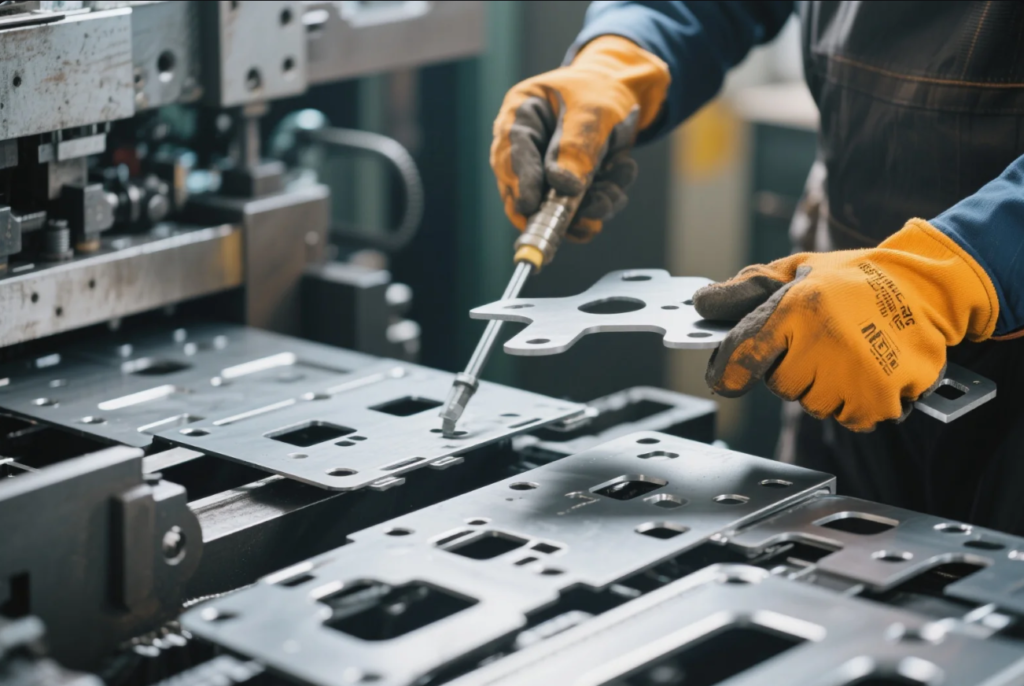
Surface finishes represent a substantial portion of the total cost for many stamped components, yet they\’re often over-specified based on aesthetic preferences rather than functional requirements. My experience reviewing component specifications has revealed numerous opportunities to reduce costs by aligning finish requirements with actual application needs.
Cost Comparison of Common Surface Finishes
Different surface finishes vary dramatically in cost and performance characteristics.
| — | ||||||||||
|---|---|---|---|---|---|---|---|---|---|---|
| Mill Finish | $ | Minimal | Industrial | Internal components, non-visible parts | ||||||
| Brushed/Polished | $$ | Minimal | Professional | Visible components, architectural | ||||||
| Zinc Plating | $$ | Good | Functional | General industrial, indoor use | ||||||
| Chrome Plating | $$$$ | Excellent | Premium | Consumer products, decorative parts | ||||||
| Powder Coating | $$$ | Very Good | Customizable | Outdoor equipment, consumer goods |
The Most Cost-Effective Materials for Industrial Stamping Parts?During a cost reduction review with Prime, we identified several internal components with decorative chrome plating that could be changed to simple zinc plating, maintaining all functional requirements while reducing finishing costs by 60%.
Strategic Approaches to Surface Finish Specification
Several strategies can optimize the cost-effectiveness of surface finishes:
- Tiered finish specifications based on component visibility
- Material selection to minimize finishing requirements
- Localized finishing only where functionally required
- Alternative finishes that provide similar performance at lower cost
- Design modifications to reduce finish-critical surface area
For a recent appliance project, I worked with Prime to implement a tiered finish specification approach. Visible components received decorative finishes, partially visible components used economical but presentable finishes, and hidden components used minimal functional finishes. This strategy reduced overall finishing costs by 28% while maintaining product aesthetics.
How does material availability impact cost-effectiveness in stamping projects?
I once specified an exotic alloy with a 12-week lead time, causing production delays that far outweighed any performance benefits the material provided.
Material availability significantly impacts stamping project cost-effectiveness. Commonly stocked materials eliminate long lead times and inventory carrying costs, while standard sizes reduce processing steps and material waste.
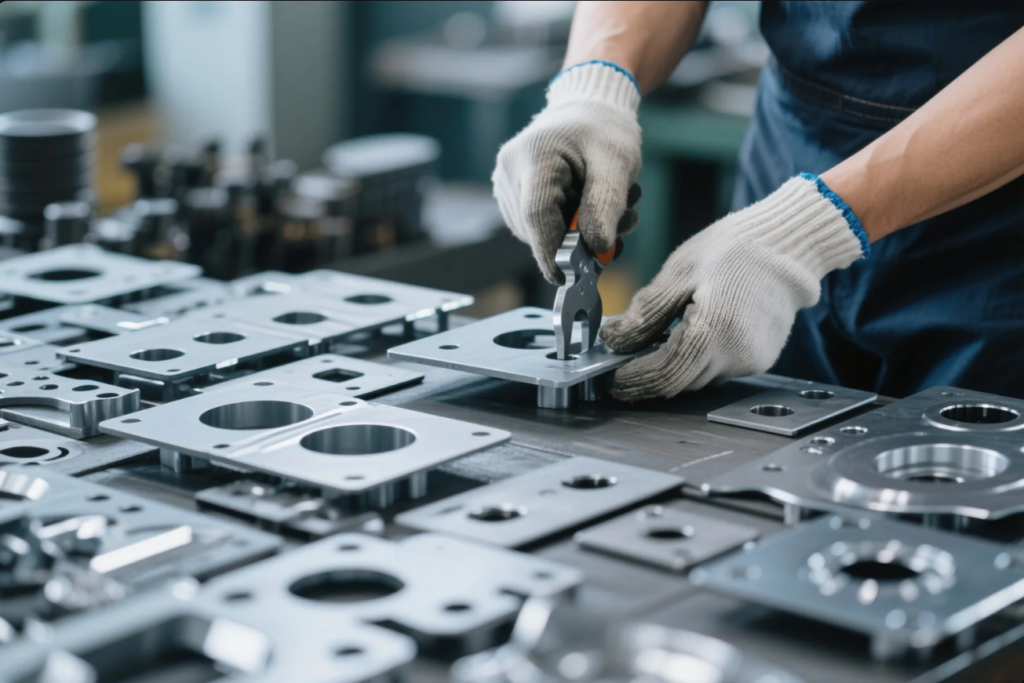
The Most Cost-Effective Materials for Industrial Stamping Parts?Material availability considerations extend beyond the simple purchase price to include lead times, minimum order quantities, and inventory management costs. My experience managing supply chains has shown that these factors can dramatically impact overall project economics, particularly for time-sensitive or variable-volume production.
Availability Comparison of Common Stamping Materials
Different materials vary significantly in availability, with important implications for project planning and costs.
| — | ||||||||||
|---|---|---|---|---|---|---|---|---|---|---|
| Carbon Steel | Excellent | 1-2 weeks | Low minimums available | Just-in-time possible | ||||||
| Stainless Steel | Good | 2-4 weeks | Moderate minimums | Safety stock advisable | ||||||
| Aluminum | Good | 2-3 weeks | Moderate minimums | Safety stock advisable | ||||||
| Copper Alloys | Moderate | 3-6 weeks | Higher minimums | Strategic inventory needed | ||||||
| Specialty Alloys | Limited | 8-16 weeks | High minimums | Long-term planning required |
The Most Cost-Effective Materials for Industrial Stamping Parts?When working with Prime on a time-sensitive project, their procurement team recommended adjusting our material specification from a specialty stainless grade to a more readily available alternative. This change reduced lead time from 8 weeks to 2 weeks, enabling us to meet a critical product launch deadline.
Strategies to Mitigate Material Availability Challenges
Several approaches can optimize material availability while maintaining performance requirements:
- Design for commonly available material grades and gauges
- Qualify multiple material options to provide flexibility
- Develop strategic supplier relationships for critical materials
- Consider inventory management costs in material selection
- Align production scheduling with material availability
For a product with seasonal demand spikes, I worked with Prime to develop a material strategy using readily available grades during peak production periods, with more specialized materials reserved for lower-volume production runs. This approach balanced performance optimization with production flexibility, reducing overall costs by 12%.
How do material handling and processing requirements affect overall cost-effectiveness?
The Most Cost-Effective Materials for Industrial Stamping Parts?I once selected a material with excellent properties but difficult processing requirements, resulting in high scrap rates and production inefficiencies that negated any performance benefits.
Material handling and processing requirements significantly impact overall cost-effectiveness. Materials requiring special handling, multiple processing steps, or specialized equipment can increase production costs by 25-100% despite similar raw material prices.

The Most Cost-Effective Materials for Industrial Stamping Parts?The processing characteristics of materials often have a greater impact on total production costs than the raw material price. My experience optimizing manufacturing processes has shown that seemingly minor differences in material properties can create significant variations in production efficiency, scrap rates, and processing costs.
Processing Comparison of Common Stamping Materials
Different materials present varying challenges during processing that affect overall costs.
| — | ||||||||||
|---|---|---|---|---|---|---|---|---|---|---|
| Low Carbon Steel | Excellent formability | Moderate tool wear | Standard lubricants | Baseline costs | ||||||
| High Strength Steel | Limited formability | Accelerated tool wear | Multiple forming stages | 30-50% higher processing | ||||||
| Stainless Steel | Work hardens rapidly | High tool wear | Special lubricants | 40-60% higher processing | ||||||
| Aluminum | Prone to galling | Moderate tool wear | Special lubricants | 20-40% higher processing | ||||||
| Copper Alloys | Excellent formability | Moderate tool wear | Surface protection needed | 15-30% higher processing |
The Most Cost-Effective Materials for Industrial Stamping Parts?During process development with Prime for a stainless steel component, their manufacturing engineers recommended changes to the forming sequence and lubricant selection. These adjustments reduced tool wear by 35% and increased production speed by 20%, significantly improving the cost-effectiveness of the stainless steel specification.
Hidden Processing Costs in Material Selection
Several less obvious factors can significantly impact the processing costs associated with different materials:
- Cleaning requirements before and after forming
- Annealing or heat treatment needs
- Special handling to prevent contamination or damage
- Scrap rates and material utilization
- Equipment setup and changeover times
For a project using a high-strength alloy, I worked with Prime to conduct a comprehensive process cost analysis. Despite similar material prices, the high-strength alloy required additional annealing steps and more frequent tool maintenance, resulting in a 45% higher total processing cost compared to a standard grade. This analysis led us to reconsider the material specification for non-critical applications.
How does recyclability impact the overall cost-effectiveness of stamping materials?
The Most Cost-Effective Materials for Industrial Stamping Parts? I initially focused only on purchase price when selecting materials, overlooking the significant value recovery possible through effective scrap management and recycling programs.
Material recyclability impacts overall cost-effectiveness through scrap value recovery and environmental compliance costs. Materials with high recycling value like copper and aluminum can offset 30-60% of raw material costs through scrap recovery.
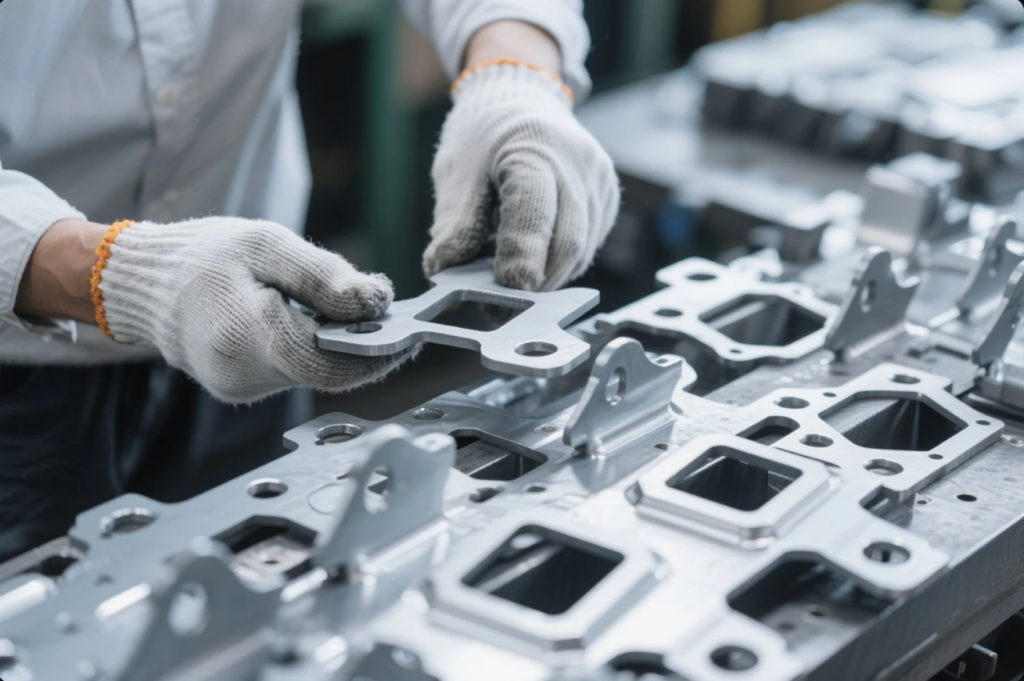
The recyclability of materials creates opportunities for significant cost recovery through effective scrap management. My experience implementing comprehensive recycling programs has demonstrated that what was once considered waste can become a valuable asset that improves overall project economics.
Recycling Value Comparison of Common Stamping Materials
Different materials offer varying levels of value recovery through recycling.
| — | ||||||||||
|---|---|---|---|---|---|---|---|---|---|---|
| Carbon Steel | 15-25% | Simple | Minimal special handling | Moderate value recovery | ||||||
| Stainless Steel | 25-40% | Moderate | Alloy separation important | Good value recovery | ||||||
| Aluminum | 40-60% | Moderate | Alloy separation beneficial | Excellent value recovery | ||||||
| Copper Alloys | 50-70% | Moderate | Alloy separation important | Superior value recovery | ||||||
| Mixed/Contaminated | 5-15% | Complex | May require special handling | Limited value recovery |
Working with Prime on a high-volume aluminum component project, we implemented a dedicated scrap collection system that maintained alloy separation. This approach increased scrap value by 35% compared to mixed collection, effectively reducing the net material cost by 22%.
Strategies to Maximize Recycling Value
Several approaches can optimize the value recovery from manufacturing scrap:
- Designing nesting layouts to produce easily recyclable scrap
- Implementing separation systems for different materials and alloys
- Establishing relationships with specialized recyclers
- Training production staff on proper scrap handling
- Considering recyclability in initial material selection
For a project using expensive copper alloys, I worked with Prime to develop a comprehensive scrap management program. By maintaining material segregation and partnering with a specialized recycler, we achieved a 65% value recovery on scrap material, significantly improving the overall economics of the high-cost material.
Contact Us
📧 Email us: [email protected]🌐 Visit: https://primecustomparts.com
Get a free quote, custom tool configuration, and fast delivery worldwide. Every order comes with setup support.
Conclusion
Selecting the most cost-effective materials for stamping parts requires looking beyond simple purchase price to consider performance requirements, processing characteristics, and lifecycle costs. By taking this comprehensive approach, you can make material choices that optimize both performance and economics for your specific application.

